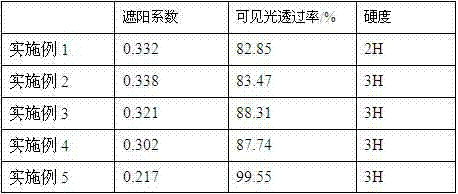Building glass thermal-insulation antifouling paint and preparation method thereof
An anti-fouling paint, architectural glass technology, applied in the direction of coating, can solve problems such as harmful substances, and achieve the effect of reducing solar radiation and simple preparation method
- Summary
- Abstract
- Description
- Claims
- Application Information
AI Technical Summary
Problems solved by technology
Method used
Image
Examples
Embodiment 1
[0022] A thermal insulation and antifouling coating for architectural glass, the components and the parts by mass of each component are as follows: 15 parts of methyl methacrylate, 5 parts of styrene, 10 parts of tricresyl phosphate, 5 parts of cellulose acetate butyrate, acetic acid 20 parts of butyl ester, 8 parts of xylene, 6 parts of dipentene, 4 parts of linolenic acid, 4 parts of corn starch sulfosuccinate, 6 parts of phthalic anhydride, 0.46 parts of methyl hydroxypropyl cellulose , 10 parts of chlorinated paraffin, 5 parts of benzoyl peroxide, 7 parts of propylene glycol methyl ether, 1 part of antioxidant dibutyl hydroxytoluene, 6 parts of light stabilizer phenyl hydroxybenzoate, surfactant dodecane 8 parts of sodium base benzene sulfonate, 5 parts of dispersant triethylhexyl phosphoric acid.
[0023] The preparation method comprises the following steps:
[0024] 1) Add methyl methacrylate, styrene and tricresyl phosphate into the reactor, stir and heat up to 40°C; ...
Embodiment 2
[0028] A thermal insulation and antifouling coating for architectural glass, the components and the parts by mass of each component are as follows: 7 parts of methyl methacrylate, 3 parts of styrene, 6 parts of tricresyl phosphate, 1 part of cellulose acetate butyrate, acetic acid 10 parts of butyl ester, 3 parts of xylene, 1 part of dipentene, 1 part of linolenic acid, 1 part of corn starch sulfosuccinate, 2 parts of phthalic anhydride, 0.08 part of methyl hydroxypropyl cellulose , 4 parts of chlorinated paraffin, 2 parts of benzoyl peroxide, 1 part of propylene glycol methyl ether, 0.1 part of antioxidant dibutyl hydroxytoluene, 3 parts of light stabilizer phenyl hydroxybenzoate, surfactant dodecane 4 parts of sodium base benzene sulfonate, 1 part of dispersant triethylhexyl phosphoric acid.
[0029] The preparation method comprises the following steps:
[0030] 1) Add methyl methacrylate, styrene and tricresyl phosphate into the reactor, stir and heat up to 40°C;
[0031]...
Embodiment 3
[0034] A thermal insulation and antifouling coating for architectural glass, the components and the parts by mass of each component are as follows: 10 parts of methyl methacrylate, 4 parts of styrene, 7 parts of tricresyl phosphate, 2 parts of cellulose acetate butyrate, acetic acid 13 parts of butyl ester, 5 parts of xylene, 3 parts of dipentene, 2 parts of linolenic acid, 2 parts of corn starch sulfosuccinate, 3 parts of phthalic anhydride, 0.18 parts of methyl hydroxypropyl cellulose , 5 parts of chlorinated paraffin, 3 parts of benzoyl peroxide, 3 parts of propylene glycol methyl ether, 0.1 part of antioxidant dibutyl hydroxytoluene, 4 parts of light stabilizer 2,4-dihydroxybenzophenone, surface active Agent sodium dodecylbenzene sulfonate 5 parts, dispersant 2 parts methyl pentanol.
[0035] The preparation method comprises the following steps:
[0036] 1) Add methyl methacrylate, styrene and tricresyl phosphate into the reactor, stir and heat up to 40°C;
[0037] 2) Ad...
PUM
| Property | Measurement | Unit |
|---|---|---|
| hardness | aaaaa | aaaaa |
| hardness | aaaaa | aaaaa |
Abstract
Description
Claims
Application Information
 Login to View More
Login to View More - R&D
- Intellectual Property
- Life Sciences
- Materials
- Tech Scout
- Unparalleled Data Quality
- Higher Quality Content
- 60% Fewer Hallucinations
Browse by: Latest US Patents, China's latest patents, Technical Efficacy Thesaurus, Application Domain, Technology Topic, Popular Technical Reports.
© 2025 PatSnap. All rights reserved.Legal|Privacy policy|Modern Slavery Act Transparency Statement|Sitemap|About US| Contact US: help@patsnap.com

